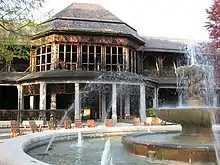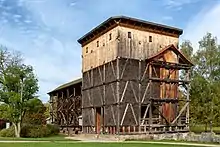
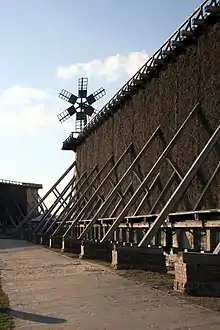
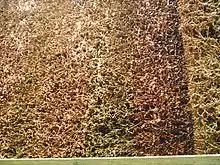
A graduation tower (occasionally referred to as a thorn house[1]) is a structure, used in the production of salt, that removes water from a saline solution by evaporation, increasing its concentration of mineral salts. The tower consists of a wooden wall-like frame stuffed with bundles of brushwood (typically blackthorn) that have to be changed every five to ten years, as they become encrusted with mineral deposits over time.[2] The salt water runs down the tower and partly evaporates. At the same time, some minerals from the solution are left behind on the brushwood twigs.
Graduation towers can be found in a number of spa towns, primarily in Germany but also Poland and Austria. The mineral-rich water droplets in the air are regarded as having beneficial health effects similar to that of breathing in sea air.
A large complex of graduation towers is located in Ciechocinek and Inowrocław, Poland.[2] This entirely wooden construction in Ciechocinek was erected in the 19th century by Stanisław Staszic. The complex consists of three towers, with a total length of over 2 km. Many tourists visit it for health reasons.
Gallery
 Graduation tower in Bad Dürrenberg
Graduation tower in Bad Dürrenberg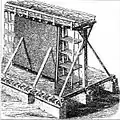 18th-century schematic
18th-century schematic Aerosol at Ciechocinek facility
Aerosol at Ciechocinek facility Graduation towers in Bad Kreuznach
Graduation towers in Bad Kreuznach
Partial list of towns and cities with graduation towers
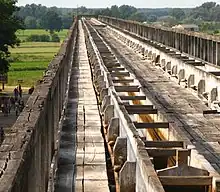
With years of initial construction where available. Does not include modern indoor facilities found in some spas.
- France
- Saulnot (16th century)
- Arc-et-Senans (1775)
- Germany
- Bad Dürkheim (1736)
- Bad Dürrenberg
- Bad Essen
- Bad Karlshafen (1986)
- Bad Kissingen (16th century)
- Bad Kreuznach (1732)
- Bad Kösen
- Bad Münster am Stein (1729)
- Bad Nauheim
- Bad Oeynhausen
- Bad Orb (1806)
- Bad Rappenau (2008)
- Bad Reichenhall (1911)
- Bad Rothenfelde (1777)
- Bad Salzdetfurth
- Bad Salzelmen (part of Schönebeck, 1756)
- Bad Salzhausen (around 1600)
- Bad Salzuflen (18th century)
- Bad Salzungen
- Bad Sassendorf
- Bad Soden (part of Bad Soden-Salmünster, 2006)
- Bad Sooden-Allendorf
- Bad Staffelstein
- Eibach (part of Dillenburg, 2004)
- Hamm (2008)
- Lüneburg (1907)
- Rheine (Saline Gottesgabe)
- Salzgitter-Bad (2009)
- Salzkotten
- Poland
- Busko-Zdrój (since 2022)
- Ciechocinek (three towers: 1824 to 1859)
- Chorzów
- Gliwice[3]
- Gołdap (since 2014)
- Grudziądz (since 2006)
- Inowrocław (since 2001)
- Katowice (since 2018)
- Konstancin-Jeziorna (since 1978)
- Kraków (two towers: in Nowa Huta and Bagry districts, since 2021)
- Latoszyn
- Radlin (since 2014)
- Rabka-Zdrój
- Rymanów-Zdrój
- Tarnów
- Ustka (since July 2020)
- Wieliczka (since 2014)[4]
- Żory (since 2023)
- Romania
- Baile Figa (2020)
- United Kingdom
References
- ↑ "Graduation House". www.thermarium.com. Archived from the original on 10 August 2014. Retrieved 9 August 2014.
- 1 2 Affelt, Waldemar: Wooden masterwork of saline in Ciechocinek, Poland Archived 2011-09-07 at the Wayback Machine, in: Santiago Huerta (ed.): Proceedings of the First International Congress on Construction History: Madrid, 20th–24th January 2003, Instituto Juan de Herrera, Madrid 2003, ISBN 84-9728-070-9
- ↑ "Tężnia solankowa". 22 September 2020.
- ↑ "The Brine Graduation Tower Wieliczka". www.visitmalopolska.pl. Retrieved 19 September 2022.
- ↑ "Company brings back salt-making in Scotland using ancient technique". The National. Retrieved 4 June 2023.
External links
![]() Media related to Graduation towers at Wikimedia Commons
Media related to Graduation towers at Wikimedia Commons

